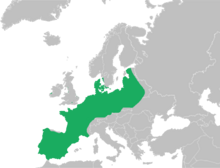Epidalea calamita
| Natterjack | |
|---|---|
 |
|
| Scientific classification | |
| Kingdom: | Animalia |
| Phylum: | Chordata |
| Class: | Amphibia |
| Order: | Anura |
| Family: | Bufonidae |
| Genus: |
Bufo Cope, 1864 |
| Species: | B. calamita |
| Binomial name | |
|
Bufo calamita Laurenti, 1768 |
|
 |
|
| Synonyms | |
|
|
The natterjack toad (Bufo calamita) is a toad native to sandy and heathland areas of Europe. Adults are 60–70 mm in length and are distinguished from common toads by a yellow line down the middle of the back, and parallel paratoid glands. They have relatively short legs, and this gives them a distinctive gait, contrasting with the hopping movement of many other toad species.
Natterjacks have a very loud and distinctive mating call amplified by the single vocal sac found under the chin of the male, so their name literally means the chattering toad - the jack (or toad) that natters (or chatters).
Natterjacks live for up to 15 years and feed mainly on insects, especially beetles. At night they move around open terrain with sparse vegetation, and in loose sand their tracks can often be seen. They move considerable distances each night, enabling the species to colonize new habitats very quickly.
The natterjack toad spawns between the end of April and July, laying strings of eggs in shallow, warm pools. Because the natterjack toad is often present in low numbers, its loud mating calls are important so that the sexes can find each other.
For natterjacks, pools need to have a very slight slope with sparse vegetation on the banks and in the water. As such pools are often temporary, sometimes the tadpoles die when the pools dry out. The natterjack compensates for that risk by mating over an extended period each summer. Thus in September the age of the juveniles can vary from a month to three months. Early breeders are not often the same individuals as the toads that reproduce later in the season, though some females do spawn twice in a year.
Populations of the natterjack extend through 17 European countries. In the British Isles the toad is now almost completely confined to coastal sites. The natterjack is the only species of toad native to Ireland. It is found on the Dingle peninsula and at Derrynane in County Kerry, and also in County Wexford where it was introduced to a dune site.
In mainland Europe, particularly in the southern part of its range, it lives inland in a variety of habitats.
In the UK the threatened status of the species resulted in the national Biodiversity Action Plan designating it as one of three protected amphibians. Reasons for its threatened status include:
...
Wikipedia

